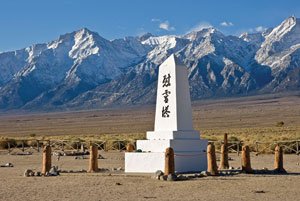I have written frequently here about the eastern Sierra. Few places in the world match the immensity and variety of natural wonders that await a visitor there; 14,000-foot peaks on each side of the Owens Valley capture the attention of most visitors, but there is much to see on the valley floor. One stands out not for its natural beauty but for its historical significance.
Halfway between Lone Pine and Independence is the site of the Manzanar War Relocation Center, the first of the 10 camps where Americans of Japanese descent were imprisoned during World War II. It opened in March 1942 as a temporary facility quaintly named the Owens Valley Reception Center, but by midyear the War Relocation Authority took over and Manzanar became a permanent camp. At its peak the camp held 10,040 prisoners. On Nov. 21, 1945 the WRA gave the last prisoners $25 cash and one-way bus fare home, if they still had one.
I first visited this area many years ago for the natural beauty unaware of Manzanar. While driving through the valley’s desolate expanse of sagebrush, I passed two lonely sentry posts by the side of the road. Curious, I turned in and began zigzagging along the grid of dirt roads that passed some old foundations and long-ignored fruit trees but not much else, until I reached the very back of the property where I found a cemetery.
Even today this spot is overpowering. Beyond the cemetery the Sierra crest rises 10,000 feet above the flat eerie emptiness of the high desert. The immensity of the Owens Valley casts a chilling and tragic poignancy over this somber spot. Inside a wood rail fence is a large white monolithic monument etched with Japanese characters that say “Soul Consoling Tower.” Of the 150 people who died in Manzanar, 15 were buried here, and only five graves remain. Who would tend these lonely remains? Yet it is clear that someone remembers.
Since my first visit years ago the National Park Service has restored the Manzanar High School Auditorium into a magnificent Interpretive Center. On my recent visit I was especially impressed that the story was not candy coated. The ugly side of white America’s hatred, the sparse conditions at Manzanar, and the tragic consequences of “relocation” are all on full display here. Many of the exhibits told moving personal stories. I wondered; how did these people endure this abomination with such dignity and pride?
One exhibit recreates the interior of a barracks where prisoners lived. Barracks were 100 feet long by 20 feet wide and divided into four 20-foot by 25-foot family “apartments.” There was no ceiling, and partitions between apartments were often a simple curtain. Prisoners endured lack of privacy everywhere including communal latrines and showers with no stalls. I tried to imagine dealing with summer’s torrid heat or the wind-whipped chills of winter in one of these tarpaper shacks.
Yet amid all this prisoners tried to fashion the trappings of a normal life behind the wires and watchtowers. They created baseball leagues, a nine-hole oiled sand golf course, churches, temples and a myriad of recreation programs and arts and crafts clubs. They even published a newspaper, the “Manzanar Free Press.”
History read in a book is abstract and impersonal. Manzanar is a place of beauty, but a very stark beauty. When you visit the eastern Sierra, stop at Manzanar. You will see and feel the imprisonment of Japanese Americans on a personal level.












